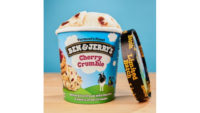
Mountain High Yoghurt

Rising Suns
This is no surprise. But the good news is that food manufacturers are aggressively responding by developing and reformulating prepared and packaged foods to better meet DGAC’s 2010 recommendations.
One of the major recommendations made in the report is to shift food intake patterns to a more plant-based diet that emphasizes vegetables, cooked dry beans and peas, fruits, whole grains, nuts and seeds. In addition, increase the intake of seafood and fat-free and low-fat milk and milk products and consume only moderate amounts of lean meats, poultry and eggs.
Another recommendation is to significantly reduce intake of foods containing added sugars and solid fats because these dietary components contribute excess calories and few, if any, nutrients. In addition, reduce sodium intake and lower intake of refined grains, especially refined grains that are coupled with added sugar, solid fat and sodium.

Coppenrath
Many formulators are including so-called superfruits, giving the product an extra healthful halo, as superfruits typically contain high levels of antioxidants, compounds recognized as warding off disease and signs of aging.
Superfruits are best described as an elite group of nutrient-rich fruits possessing beneficial health properties. The list of superfruits is constantly growing, ranging from the well recognized (blueberry) and the increasingly more familiar (pomegranate) to the exotic (maqui berry) and the emerging (prickly pear).

S&P Marketing Inc.
The prickly pear (Opuntia ficus-indica), also known as the cactus pear, is a dessert succulent. Among the cacti, the prickly pear has the greatest number of species, with more than 200 varieties grown throughout the Americas. The prickly pear plant has modified leaves in the form of thorns, shallow roots to absorb available surface moisture and the ability to convert water into a mucilaginous substance to increase its water store. This produces fruit with pulp high in soluble fiber and rich in antioxidants and an array of nutrients, in particular magnesium. Along with being naturally sweet and possessing a uniquely pleasant flavor profile, the prickly pear plant grows in a variety of colors, lending itself as a natural colorant to many foods.

S&P Marketing Inc.
These benefits, among others, combined with the appealing color, flavor, nutrition and sweetness that prickly pear brings to foods and beverages, are the reasons why formulators are increasingly pursuing the addition of this fruit to applications. Prickly pear crops are also proliferating in the States, which appeals to formulators who desire domestically grown fruit ingredients.
A fruit supplier exhibiting at the 2010 IFT Annual Meeting + Food Expo in Chicago this past July focused on its array of prickly pear offerings. This included ruby red, which has a bright magenta color and a delicate, slightly sweet, cactus flavor. The emerald prickly pear is not as eye-catching as ruby red, but possesses a very sweet fruit flavor that renders itself more appropriate to certain applications. Both are available as juice, concentrate and purée ingredients.
Dairy products are the perfect delivery vehicle for prickly pear, as well as most fruits. The dairy industry has the ability to deliver on DGAC’s recommendations. Let’s reconnect!






